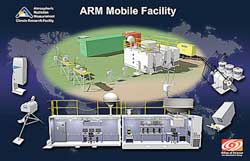Have profiling microwave radiometer, will travel

ARM Mobile Facility - Credit: PNNL’s Photo Library
Pacific Northwest National Laboratory set to launch million-dollar mobile atmospheric-measuring station on worldwide tour to fill data gaps in global climate models
Balloon-borne sounding system. Check. Micropulse lidar. Check. Infrared thermometer. Check. Eddy correlation flux measurement system. Eddy correlation flux measurement system?! Check already.
These and a dozen other instruments and computer- and maintenance-shop-jammed cargo containers make up the ARM Mobile Facility, or AMF, the world’s most sophisticated moveable, atmospheric-measuring suite. In early February, the AMF will be carefully packed and shipped from the Department of Energy’s Pacific Northwest National Laboratory, where the system was designed, assembled and is being tested, to Point Reyes National Seashore, north of San Francisco.
There it will be reassembled and take in the local atmosphere, literally, for nine months before heading to sub-Saharan Africa , in time for the 2006 monsoon season in Niger . The instruments are designed to withstand temperatures from minus-40 to plus-120 degrees Fahrenheit, said PNNL’s Kevin Widener, AMF chief engineer and supervisor for the testing.
The station is designed to measure the physical properties of literally anything that blows over and the heat that radiates from clouds and from the ground, said Widener, who, with Tom Ackerman, a Battelle fellow at PNNL, designed and put together the $1.4 million system at the behest of the DOE Office of Science.
The AMF is part of DOE’s Atmospheric Radiation Measurement (ARM) Climate Research Facility, which already includes fixed sites in Oklahoma , the North Slope of Alaska and the Tropical Western Pacific region near northeastern Australia . The AMF expands the ARM program’s reach into additional climatic regions, providing critical information now missing in models.
Besides PNNL’s engineering team, key collaborators in the AMF project include Argonne , Brookhaven and Los Alamos national laboratories. For more information, see http://www.arm.gov/ and http://www.arm.gov/sites/amf.stm .
PNNL ( www.pnl.gov ) is a DOE Office of Science laboratory that solves complex problems in energy, national security, the environment and life sciences by advancing the understanding of physics, chemistry, biology and computation. PNNL employs 3,800, has a $600 million annual budget, and has been managed by Ohio-based Battelle since the lab’s inception in 1965.
Media Contact
More Information:
http://www.pnl.govAll latest news from the category: Ecology, The Environment and Conservation
This complex theme deals primarily with interactions between organisms and the environmental factors that impact them, but to a greater extent between individual inanimate environmental factors.
innovations-report offers informative reports and articles on topics such as climate protection, landscape conservation, ecological systems, wildlife and nature parks and ecosystem efficiency and balance.
Newest articles

Webb captures top of iconic horsehead nebula in unprecedented detail
NASA’s James Webb Space Telescope has captured the sharpest infrared images to date of a zoomed-in portion of one of the most distinctive objects in our skies, the Horsehead Nebula….

Cost-effective, high-capacity, and cyclable lithium-ion battery cathodes
Charge-recharge cycling of lithium-superrich iron oxide, a cost-effective and high-capacity cathode for new-generation lithium-ion batteries, can be greatly improved by doping with readily available mineral elements. The energy capacity and…

Novel genetic plant regeneration approach
…without the application of phytohormones. Researchers develop a novel plant regeneration approach by modulating the expression of genes that control plant cell differentiation. For ages now, plants have been the…





















